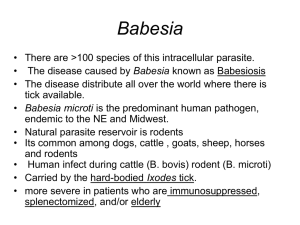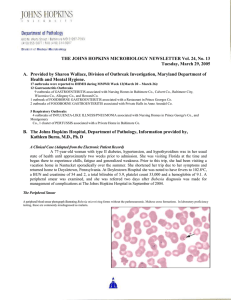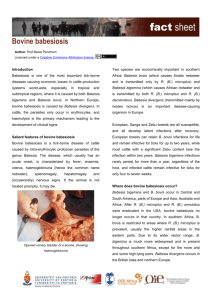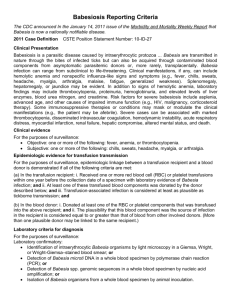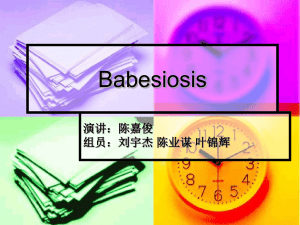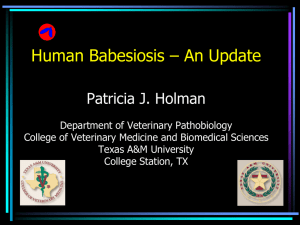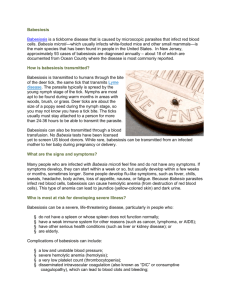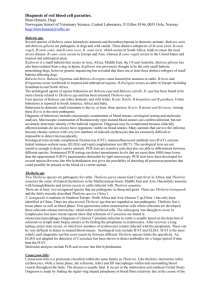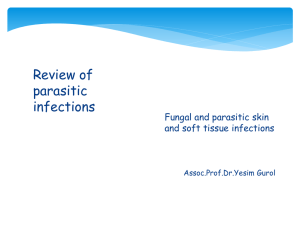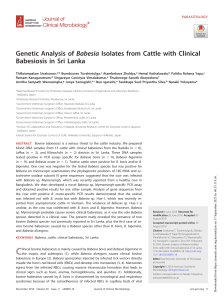babesia - Tufts University
advertisement
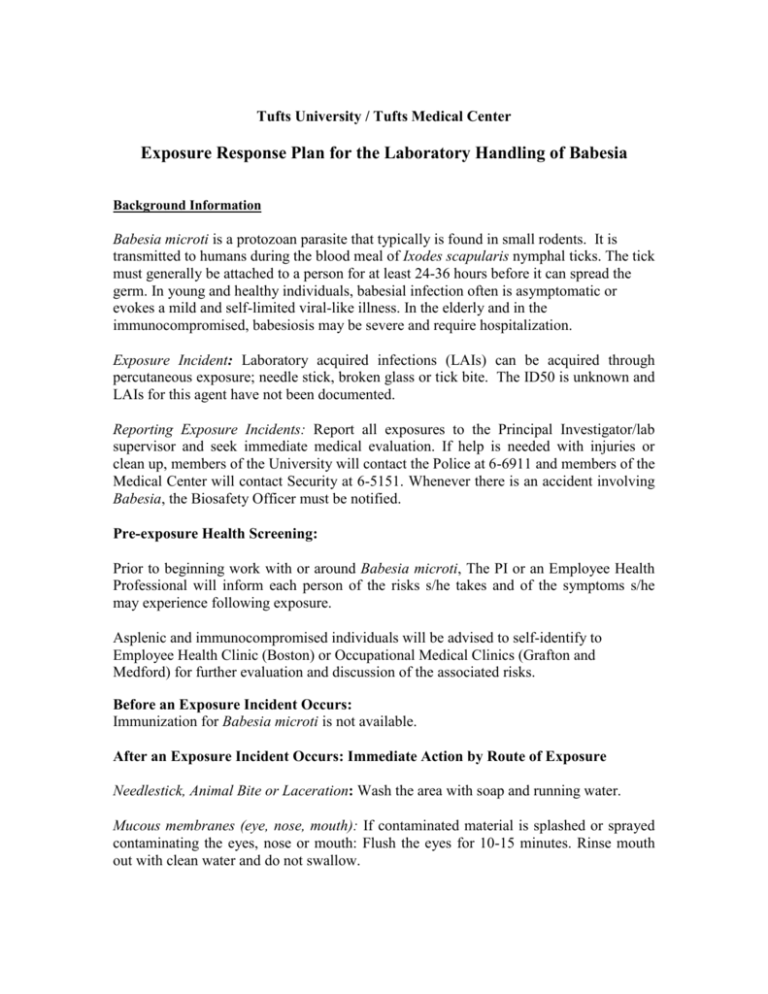
Tufts University / Tufts Medical Center Exposure Response Plan for the Laboratory Handling of Babesia Background Information Babesia microti is a protozoan parasite that typically is found in small rodents. It is transmitted to humans during the blood meal of Ixodes scapularis nymphal ticks. The tick must generally be attached to a person for at least 24-36 hours before it can spread the germ. In young and healthy individuals, babesial infection often is asymptomatic or evokes a mild and self-limited viral-like illness. In the elderly and in the immunocompromised, babesiosis may be severe and require hospitalization. Exposure Incident: Laboratory acquired infections (LAIs) can be acquired through percutaneous exposure; needle stick, broken glass or tick bite. The ID50 is unknown and LAIs for this agent have not been documented. Reporting Exposure Incidents: Report all exposures to the Principal Investigator/lab supervisor and seek immediate medical evaluation. If help is needed with injuries or clean up, members of the University will contact the Police at 6-6911 and members of the Medical Center will contact Security at 6-5151. Whenever there is an accident involving Babesia, the Biosafety Officer must be notified. Pre-exposure Health Screening: Prior to beginning work with or around Babesia microti, The PI or an Employee Health Professional will inform each person of the risks s/he takes and of the symptoms s/he may experience following exposure. Asplenic and immunocompromised individuals will be advised to self-identify to Employee Health Clinic (Boston) or Occupational Medical Clinics (Grafton and Medford) for further evaluation and discussion of the associated risks. Before an Exposure Incident Occurs: Immunization for Babesia microti is not available. After an Exposure Incident Occurs: Immediate Action by Route of Exposure Needlestick, Animal Bite or Laceration: Wash the area with soap and running water. Mucous membranes (eye, nose, mouth): If contaminated material is splashed or sprayed contaminating the eyes, nose or mouth: Flush the eyes for 10-15 minutes. Rinse mouth out with clean water and do not swallow. Tick Removal: Use fine-tipped tweezers and protect your fingers with gloves. Avoid removing ticks with your bare hands. Grasp the tick as close to the skin surface as possible and pull upward with steady, even pressure. Don't twist or jerk the tick; this can cause the mouth-parts to break off and remain in the skin. If this happens, remove the mouth-parts with tweezers. If you are unable to remove the mouth easily with clean tweezers, leave it alone and let the skin heal. After removing the tick, thoroughly clean the bite and your hands with rubbing alcohol, an iodine scrub, or soap and water. Inhalation: If contaminated materials are aerosolized outside of primary containment and potentially inhaled, rinse mouth twice expelling the rinsate. Do not swallow. Contact with intact skin and clothing: Remove contaminated clothing using gloves and place objects in plastic bags. Wash contaminated skin with soap and water. After an exposure incident occurs: medical evaluation and follow-up: Following immediate post exposure actions, contact the TMC Employee Health Clinic (Boston), TCSVM Occupational Medical Clinic (Grafton) or the Mt. Auburn Occupational Health Services (Medford) and arrange for medical evaluation, diagnosis and treatment if needed. During this appointment, the exposed individual will be asked to provide a blood sample (for baseline Babesia specific antibody titer), will be informed of the signs and symptoms of babesiosis, and will be instructed to watch for the development of these signs and symptoms. The exposed individual will also be asked to provide a second blood sample 4-6 weeks following exposure (to monitor Babesia specific antibody titers and to detect Babesia organisms on Giemsa stained blood smears or by PCR). Signs and Symptoms of Babesiosis include: Young (< 50 years of age) and healthy individuals: Gradual onset of fatigue, malaise and weakness. Fever (>38°C) is intermittent or sustained, and may reach 41°C. o Fever is accompanied by one of more of the following: chills, sweats, headache, myalgia, arthralgia, and anorexia. o Less common symptoms include neck stiffness, sore throat, dry cough, shortness of breath, weight loss, nausea, vomiting, diarrhea, and dark urine. Asplenic, immunocompromised or older individuals (>50 years of age): The number and intensity of symptoms are higher. Despite antimicrobial therapy, the fatality rate is ~5% among the hospitalized, and ~20% among the immunocompromised. Severely ill may develop complications, including acute respiratory distress syndrome, disseminated intravascular coagulation, congestive heart failure, renal failure, myocardial infection, splenic infarcts and splenic rupture. Immunocompromised patients may experience persistent or relapsing symptoms.. The incubation period typically lasts from 1 to 6 weeks. If an exposed individual experiences signs or symptoms of babesiosis, s/he must immediately notify the PI and the campus Biosafety Officer. S/he also must be evaluated at TMC Employee Health Clinic (Boston), referred to an ID specialist by the TCSVM Occupational Health nurse (Grafton), or evaluated by a physician at the Mount Auburn Occupational Health Services (Medford). Babesiosis is diagnosed by microscopic examination of Giemsa stained thin blood smears. At the onset of signs and symptoms, when parasitemia is low, identification of parasites may require multiple blood smears over several days. If parasites are not visualized and yet babesiosis is suspected, PCR is recommended. Serology is useful to confirm the diagnosis. Post-exposure prophylaxis: There is currently no post exposure pre-symptom prophylaxis for Babesia microti. Asymptomatic infections need not be treated, unless Babesia organisms are detected on blood smear or by PCR for >3 months. Symptomatic infections need not be treated if Babesia organisms are not detected, despite positive serology. When Babesia organisms are detected in symptomatic patients, treatment should be initiated. The Health Care Provider will verify current and recommended diagnostic and treatment modalities. Massachusetts Department of Public Health classifies Babesiosis as a reportable disease and must be reported to the Local Board of Health immediately by the attending physician. In accordance with Massachusetts regulation, any clinical laboratory identifying an infection caused by a Babesia species may be reported to the Massachusetts Department of Public Health in accordance with disease-reporting regulations. If an employee develops signs and symptoms associated with Bebesia exposure in the absence of an exposure incident and appropriate travel history, the PI and Biosafety Officer shall be notified immediately. The infection will be considered laboratoryacquired until proven otherwise.
